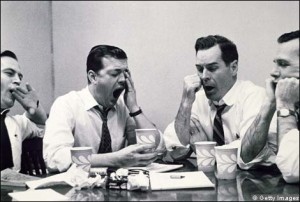YAWNING
VI. Norepinephrine (NE)
A. Synthesis of 4,5-b-trihydroxyphenethylamine
1. precursor: tyrosine (Tyr)
a. tyrosine hydroxylase
(TH, an oxidase, rate limiting enzyme)
2. L-DOPA (levo-dihydroxyphenylalanine)
a. DOPA decarboxylase (aromatic aa decarboxylase)
3. dopamine (DA)
a. CO2 released
b. dopamine b-hydroxylase (DBH)
i. DA neurons have no DBH
(1) genes encoding enzymes independently regulated
(2) genes for TH, DBH, & PNMT very similar
(3) on the same chromosome
(4) regulation can be coordinated
4. norepinephrine (NE) =4,5-b-trihydroxyphenethylamine
a. phenylethanolamine-N-methyltransferase (PNMT)
i. NE neurons have no PNMT
(1) found in the adrenal medulla
(2) also centrally
5. epinephrine (Epi)
6. tyramine and octopamine may be transmitters
in invertebrates
B. NE is synthesized in the locus ceruleus (for its bluish appearance)
1. few cells in the caudal pontine central gray
a. rats: 1,500 humans: 12,000
2. NE cells scattered in the lateral tegmental area
3. also made by the postganglionic neurons of the
sympathetic nervous system
a. & adrenal medullary chromaffin cells
i. releases into bloodstream as a hormone
C. Adrenergic Receptors
1. bind NE and Epi
2. a1 & a2 bind Epi > NE
a. a1A-D in brain, olfactory buly, vas deferens and blood vessels
ö DG Þ PKC
i. GpÞPLC ÞPIP2 ÞIP3 ÞCa++
b. a2A-C in presynaptic nerve terminals (Gi brain);
i. Gi ÞX AC (\Þ X cAMP, PKA, CREB)
3. b1 & b2 bind Epi > NE
a. b1 & b2 in cerebrum and cerebellum
b. b3 in fat (Ca++ channel)
c. Gs Þ AC Þ cAMP Þ PKAÞ CREB
D. Reuptake and Degradation
1. most synaptic NE is recaptured via the NET(NE transporter)
a. \ transmitter function is terminated
b. also some taken back up by OCT (organic cation transporters)
2. catabolism involves COMT, MAO,
aldehyde dehydrogenase and redutase
i. sympathetic catabolism results in vanilly-mandelic acid
ii. central catabolism results in MHPG
(3-methoxy-4-hydroxyphenylglycol)
(1) intraneuronal catabolism has DOPEG
(3-4- dihydroxyphenylglycol) as intermediate
(2) synaptic normetanephrine
E. NE has broad projections with extensive collaterals & dense terminal arborizaitons
1. primarily via the dorsal catecholamine bundle
a. smaller LC paths: dorsal periventricular system
& central tegmental tract
b. also via ascending cerebellar peduncle
and toward medulla and spinal cord
2. a & b receptors in the prefrontal cortex, cingulate cortex, olfactory bulb
hippocampus, BNST, thalamus, hypothalamus,
reticular formation, cerebellum, and spinal cord
a. few terminals within a given region - NE secreted diffusely
i. neuromodulatory
(1) e.g. ñ excitability of Hippocampal cells (b)
(a) NE is secreted during aggressive behavior
(2) or ò cortical excitability (a)
2. lateral tegmental NE cells project to the amygdala, septum, thalamus,
hypothalamus (including PVN), brainstem and spinal cord
a. regulation of releasing hormones
b. integration of autonomic function
i. projections to nuclei of solitary tract, dorsal vagus, and
intermediolateral column
(1) activate parasympathetic ò HR and BP
3. also secreted by the postganglionic neurons of the
sympathetic nervous system
VII. Oxytocin (OT)
VIII. ACTH & aMSH
